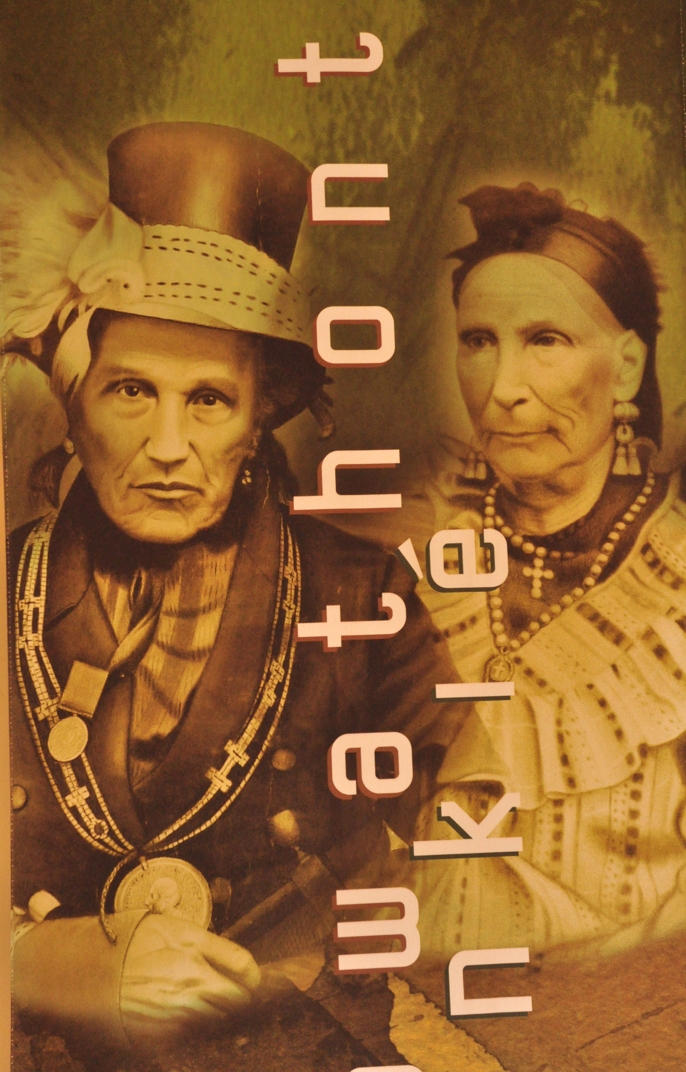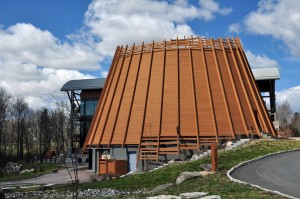Story and photographs by:
Ursula Maxwell-Lewis
WENDAKE, QUEBEC: A Huron-Wendat woman drummer wends her way between the Sagamité Restaurant brunch tables. Today- Mother’s Day – she has been given special permission to drum. Traditionally, drumming is exclusively a male role in the Nation. Thump. Thump. The ancient sound is strangely unobtrusive – a subliminal reminder of time and place underlying the buzz of family chatter. Occasionally she pauses, encouraging children to inspect her white hand drum. My bright-eyed 7-year-old prairie grandson, Kaden, would have been there in a drumbeat. Eventually she wanders upstairs to greet visitors on  the reception level of the four-star First Nations Hotel-Museum.
the reception level of the four-star First Nations Hotel-Museum.
Nibbling on sturgeon, turbot, eel, a selection of hot entrees and an array of local cheeses, I admire the golden warmth of the massive timbers and totems. Full-length windows frame a grove of silver birches edging the racing St Charles River (also known as Akiawenrahk meaning “the river of a thousand meanders”) a safe distance away. I also note the $27 brunch price-tag (regularly $23). That’s a far cry from the cost of Mother’s Day brunches in BC’s Lower Mainland.
An easy drive north of Quebec City, the obviously thriving Aboriginal tourism and interpretive complex is clearly a source of pride in this well-run urban reserve. A quick room tour with Danisse Neashit, the hotel Marketing Coordinator, reveals airy spacious rooms capitalizing on the sight and sound of the rushing river beyond. Beaver pelts and signature wool blankets on the beds together with classic dream catcher signify a different space and place.
Capitalizing on an expanded interpretive core structure smokehouse and long house design, the street side of the hotel is windowless to emphasize the impact of nature lavishly profiled at the back. Wisely the Band Council has not only encouraged and supported the collecting and assembling of hotel museum artifacts, but has clearly encouraged incentive, employment, and training for locals resulting in a waiting list for houses.
Young guides were not only well informed, but obviously proud of their impressive heritage. While the history is treasured, techno-savvy Tourism and Marketing Coordinator, Jason Picard-Binet, showed off the new free Wendake apps on his iPad via free hotel Wi-Fi.
Another first for the Huron-Wendat Nation will be the staging of Shakespeare’s The Tempest by Robert Lepage (EX MAHINA) in the Wendake amphitheatre near the St. Charles River throughout July.
Near the hotel (easily reached via a well used bike and jogging path) is Kabir Kouba Falls. This year’s run-off is particularly stunning pounding down 42 metres onto the rocks of the Canadian Shield. Footpaths in the Parc de la Falaise along the river. The nearby woods house rich plant life, and (so I’m told) fossils dating back over 455 million years.
Historically, the Huron-Wendat of Wendake (formerly called the Hurons of Lorette) hailed from the Georgian Bay region. In 1634 the Huron numbered between 20,000 and 30,000 people. However, by 1650, wars with the Iroquois, French and British reduced the population to a few hundred souls. It was only in 1697 that they finally settled in their current location, the village of Lorette, which until recently was called the Huron Village.
 While my heart is with my children and grandsons on the other side of this great land, the history and determination of a people who have proudly overcome much adversity touches me. Since motherhood is synonymous with birth, teaching, and strength, Wendake seems an appropriate place to celebrate Mother’s Day.
While my heart is with my children and grandsons on the other side of this great land, the history and determination of a people who have proudly overcome much adversity touches me. Since motherhood is synonymous with birth, teaching, and strength, Wendake seems an appropriate place to celebrate Mother’s Day.
More information go to www.bonjour-quebec.com andwww.wendake.com
Ursula Maxwell-Lewis is a freelance writer and founding editor of the Cloverdale Reporter News, She was introduced to this region by www.quebecregion.com